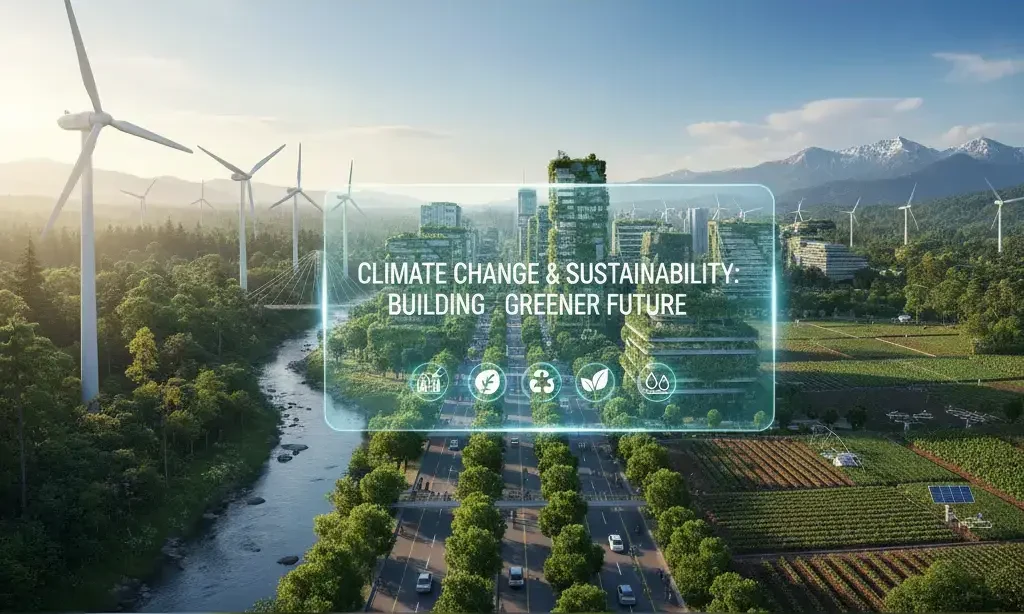Climate change has become one of the most pressing challenges of the 21st century, reshaping ecosystems, economies, and human lives worldwide. Rising global temperatures, melting glaciers, frequent wildfires, and unpredictable weather patterns are stark reminders that the Earth is under stress. The concept of sustainability—meeting present needs without compromising the ability of future generations to meet theirs—has emerged as a guiding principle for tackling this crisis. This article explores the science behind climate change, its impacts, the importance of sustainability, and how individuals, businesses, and governments can work together to build a greener future.
Understanding Climate Change
Climate change refers to long-term shifts in global or regional climate patterns, primarily driven by human activities. The primary cause is the greenhouse effect, triggered by the accumulation of gases like carbon dioxide (CO₂), methane (CH₄), and nitrous oxide (N₂O) in the atmosphere. These gases trap heat, leading to a steady increase in Earth’s average temperature.
Key contributors include:
- Burning Fossil Fuels – Coal, oil, and natural gas for electricity, transport, and industry.
- Deforestation – Cutting trees reduces Earth’s ability to absorb carbon dioxide.
- Industrial Processes & Agriculture – Fertilizers, livestock farming, and chemical use add to emissions.
- Waste Management – Landfills release methane, a potent greenhouse gas.
The Global Impact of Climate Change
The consequences of climate change are visible across the globe:
- Rising Temperatures
Average global temperatures have risen by 1.1°C since the pre-industrial era, pushing ecosystems and species to their limits. - Extreme Weather Events
Hurricanes, floods, droughts, and heatwaves are becoming more frequent and severe. - Melting Ice and Rising Seas
Polar ice sheets are shrinking, contributing to rising sea levels that threaten coastal cities and small island nations. - Biodiversity Loss
Many species face extinction as their habitats disappear or change rapidly. - Economic Disruption
Agriculture, tourism, and fisheries are heavily impacted, especially in developing countries.
What is Sustainability?
Sustainability is about balancing environmental, social, and economic needs to ensure long-term prosperity. It focuses on three main pillars:
- Environmental Sustainability – Conserving natural resources, reducing waste, and protecting biodiversity.
- Social Sustainability – Ensuring equality, education, and access to resources for all communities.
- Economic Sustainability – Encouraging practices that support economic growth without harming the planet.
This framework helps guide policies and decisions toward a future where humans and nature can coexist harmoniously.
The Role of Renewable Energy
One of the most effective strategies to combat climate change is transitioning to renewable energy sources:
- Solar Power – Harnessing sunlight to generate electricity.
- Wind Energy – Turbines that convert wind into power.
- Hydropower – Using water flow to produce electricity.
- Geothermal Energy – Utilizing Earth’s internal heat.
- Biomass – Renewable organic materials as fuel.
These sources are cleaner, sustainable, and increasingly cost-competitive compared to fossil fuels.
Sustainable Practices in Daily Life
Individuals play a crucial role in building a sustainable future. Simple lifestyle changes can collectively make a huge difference:
- Reduce, Reuse, Recycle – Minimize waste and conserve resources.
- Conserve Energy – Use energy-efficient appliances, switch to LED bulbs, and unplug devices when not in use.
- Sustainable Transport – Walk, cycle, use public transport, or switch to electric vehicles.
- Mindful Consumption – Support eco-friendly brands and buy local products.
- Diet Choices – Reduce meat consumption, as livestock farming is a major emitter of greenhouse gases.
The Role of Businesses and Governments
While individuals make an impact, large-scale change requires systemic action:
- Businesses – Many corporations are adopting ESG (Environmental, Social, and Governance) policies, aiming for net-zero emissions and sustainable supply chains.
- Governments – International agreements like the Paris Agreement commit nations to limit global warming below 2°C, ideally 1.5°C. Policies like carbon taxes, green subsidies, and renewable energy mandates are crucial.
- Innovation & Technology – Carbon capture, sustainable agriculture, and smart cities are emerging solutions.
Challenges to Sustainability
Transitioning to a sustainable future is not without obstacles:
- Economic Costs – Renewable infrastructure requires heavy investment.
- Political Resistance – Short-term interests often outweigh long-term goals.
- Inequality – Developing nations face greater challenges adapting due to limited resources.
- Behavioral Barriers – Many individuals and businesses resist lifestyle and operational changes.
Hope for the Future
Despite the challenges, there is reason for optimism. Global awareness is rising, and younger generations are leading climate movements. Green technologies are becoming more affordable, and international cooperation is stronger than ever. The path ahead requires persistence, innovation, and collaboration.
Conclusion
Climate change is one of humanity’s greatest challenges, but it is also an opportunity to rethink how we live and grow. By embracing sustainability, investing in renewable energy, and fostering global cooperation, we can slow down and eventually reverse the damaging trends. Every action—big or small—contributes to building a greener, fairer, and more resilient planet.
